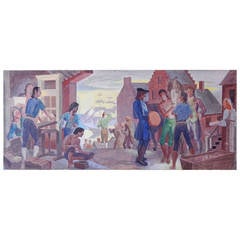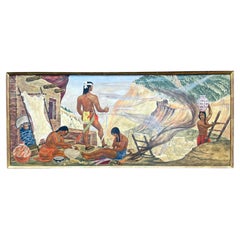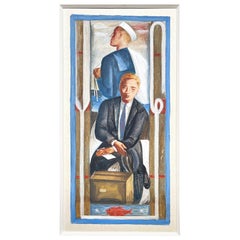Want more images or videos?
Request additional images or videos from the seller
1 of 7
"Livestock Farm Scene, " WPA Mural Study with Farmhands Handling Hay and Feed
Price:$3,900
About the Item
- Creator:Rollin Crampton 1 (Painter)
- Dimensions:Height: 12.5 in (31.75 cm)Width: 18.75 in (47.63 cm)Depth: 1 in (2.54 cm)
- Style:Art Deco (Of the Period)
- Materials and Techniques:
- Place of Origin:
- Period:
- Date of Manufacture:Circa 1930s
- Condition:
- Seller Location:Philadelphia, PA
- Reference Number:1stDibs: LU865131927062
About the Seller
4.9
Vetted Professional Seller
Every seller passes strict standards for authenticity and reliability
Established in 2005
1stDibs seller since 2009
480 sales on 1stDibs
Authenticity Guarantee
In the unlikely event there’s an issue with an item’s authenticity, contact us within 1 year for a full refund. DetailsMoney-Back Guarantee
If your item is not as described, is damaged in transit, or does not arrive, contact us within 7 days for a full refund. Details24-Hour Cancellation
You have a 24-hour grace period in which to reconsider your purchase, with no questions asked.Vetted Professional Sellers
Our world-class sellers must adhere to strict standards for service and quality, maintaining the integrity of our listings.Price-Match Guarantee
If you find that a seller listed the same item for a lower price elsewhere, we’ll match it.Trusted Global Delivery
Our best-in-class carrier network provides specialized shipping options worldwide, including custom delivery.You May Also Like
Massive WPA Mural Study
Located in Palm Springs, CA
We acquired his large mural study out of an old Hudson River valley estate. It had been rolled up for years. It appears to have been cut down on the left side. Clearly a WPA Mural pr...
Category
Vintage 1930s American Paintings
Materials
Paint
WPA Street Scene Painting American School
Located in Wiscasset, ME
WPA street scene painting American school. Unsigned, could be NYC.
Category
Vintage 1960s American Folk Art Paintings
Jean-Baptiste Scoriel, Hay Meadow Scene, 1930
Located in Barntrup, DE
A beautiful painting of a hay meadow scene by Jean-Baptiste Scoriel.
Hay meadow scene, 1930, oil on board, 33 cm x 38 cm, signed and dated (lower right)....
Category
Vintage 1930s Belgian Paintings
Materials
Other
Lucien Desmaré '1905-1961', Farm scene with Peasants, Framed and Signed
Located in Leuven , BE
Lucien Desmaré was a Belgian painter born in 1905 and who died in 1961. He was a painter, etcher, illustrator and decorator. He has followed training at the Academies in Anderlecht, ...
Category
20th Century Belgian Decorative Art
Materials
Paper
$289 Sale Price
40% Off
H 20.67 in W 26.58 in D 0.79 in
Oil on Canvas Farm Scene
Located in Nashville, TN
This 19th-century English oil original paintingis perfect for a farmhouse, rustic, or scenic-inspired room in your living space. It depicts a barn alongside a dirt road, with another...
Category
Antique Early 1900s English Paintings
Materials
Paint
Rustic Hay Cottage Oil Painting, Countryside Scene, 1900s
Located in Lisbon, PT
Signed oil painting capturing the timeless charm of rural life, featuring a serene countryside path, a shepherd guiding his flock, and a quaint hay-thatched cottage under the shade o...
Category
20th Century French Paintings
Materials
Canvas
$1,481 Sale Price
20% Off
H 24.41 in W 32.29 in D 1.58 in
Wayne Pate, Jug With Handle Study No.III
Located in London, GB
Gouache
H52 x W41 cm (framed dimensions)
Category
Mid-20th Century Paintings
Materials
Paint
Pfoutz Original Farm Scene Oil Painting
Located in Annville, PA
A very interesting and unusual Pfoutz Original Farm Scene Oil Painting by artist J. Earle Pfoutz. The painting is produced on artist and comes complete with what appears to be an original artist decorated/painted frame. The Pfoutz Original Farm Scene Oil Painting is signed on the front by the artist and appears to be dated 1948 on the rear. Known for his unusual subjects Pfoutz outdid himself with this effort, capturing the essence of a Lancaster County farm but with the startling twist of portraying a large turkey vulture in the foreground. Definitely unique.
Overall frame Size approximately 33″ wide x 3″ deep x 26″ high
J. Earle Pfoutz had a long and distinguished career as a self trained artist. More can be learned about him from reading this article produced by Gary Hawbaker at askART
Earle Pfoutz Born: 1891 – Lancaster, Pennsylvania
Died: 1957
Known for: Landscape, figure, still life painting
An image of J Earle Pfoutz
Biography from the Archives of askART
J. Earle Pfoutz (John Earle Pfoutz) – (Oct 23, 1891-Nov 9, 1957)
“A seventh generation descendant of a Swiss family which arrived in America early in the 17th Century, J. Earle Pfoutz was born in Lancaster, PA, son of John Bachman and Susan Allison Pfoutz. He painted houses for a living and pictures for a life.
A self-taught artist, described as a primitive, he was distinctive for his vivid imagination and bold color application. He painted hundreds of Lancaster County scenes. Pfoutz traveled through the hills near his home and along the Susquehanna River in search of scenes. He began painting with a brush when he was fourteen, but added a palette knife after suffering an eye injury. He completed eighth grade in the Lancaster Public Schools and there his formal education ended. However, the Department of Public Instruction of the State of Pennsylvania thought so highly of his work as an artist that officials certified him as an art instructor and he taught for a year in the York (PA) public schools. He also was an art instructor under the program for disabled veterans, sponsored by the Veterans Administration, when he gave private instruction to veterans in their homes.
In 1947, J. Earle Pfoutz finally earned national recognition as an artist. His painting, Opalescent October, was chosen by the Museum of Art of Dayton Ohio, to travel all over the country for a year with its Group Exhibition. Described as a “very colorful, calm scene, iridescent in color, sweeping in design,” the painting started on its journey around the country early in 1948. In an interview with the Sunday News (Lancaster, PA – Nov 2, 1947), Pfoutz stated that he didn’t know whether he was a “primitive” or an “impressionist.” No master taught him, no school channeled his style. “Sometimes I didn’t eat, but I always managed to paint,” he recalled. Many of his hundreds of canvases -most of them not sold, but given away to friends – found their way to other parts of the country. “I never remember the day when I did not love color,” Pfoutz said. “I was about 12 years old when I saw my first palette – a string of different colored paint paddles that graced the stores of that day. As a boy I had two great desires. One was to be able to eat all the strawberry jam I could, and the other to possess a string of those beautiful paint paddles. Well, I’ve got my fill of jelly, but I’ve never yet got my fill of beautiful colors.”
In 1950, Pfoutz’s one man show of paintings made front page headlines in the Lancaster Intelligencer Journal: “Most of the twenty oil paintings on exhibition are landscapes, although there are several interesting figure studies. Colors again, as in all Pfoutziana are rich and full-bodied, but for the most part not as startlingly as in some of the earlier work. Most of the paintings were done during the past year, and also reveal the painter’s characteristic heavy impasto technique, in which the rich swirls of paint carry their own message. Among the figures, The Banjo Picker, and The Magician, are the most provocative. Both are character studies; the first being of a tramp musician whose drab clothing is set-off by a luminous aqua blue background. Modern in feeling and treatment is The Magician, a clown-faced wizard whose spinning ball in the air suggests the fourth dimension – space. The use of the primary colors in this picture serves to emphasize the theme effectively.
A large colorful landscape, Opalescent October, depicting rolling hills against a late afternoon sky is new to Lancastrians, as it has just returned from Dayton, Ohio, where it hung in the Dayton Art Institute. Another landscape with soft dreamy colors is Fantasie D’Autumne, and one of the loveliest pictures in the show. Pennsylvania Dutch Country is another with eye appeal, and was one of the works which was hung in the Old Customs House in Philadelphia during Pennsylvania Week, and before that in a collection of Pfoutz work in the same place. In deep contrast to the sunny skies and brilliant foliage of many of the pictures, is the somewhat morbid Worry, in which the center of interest is a tremendous rat. This, the painter explains, was symbolic of 1948 in China, which was ‘The Year of The Rat’ in the Chinese calendar. Background material for the picture was furnished to Pfoutz by author Pearl Buck.
Other pictures include Autumn Prelude, Miners Village, painted at Cornwall, PA; Humid Day, Saint Peters Kierch, at Middletown, PA; Lady Pfoutz, inspired by the painter’s wife; Sun Flowers, Sentimental Journey, Gyne, Luzon Woman, Old Bridge, The Cow Path. Lemures, based on Roman mythology, and Ethiopian, painted from an ebony wood carving from Kenya Province, S. Africa.”
In 1953, Pfoutz was installed as President of the Lancaster County Art Association. A. Z. Kruse, New York City artist, writer and member of the faculty of the Brooklyn College and the Cartoonists and Illustrators School, Manhattan, was the guest speaker. In January of 1953, thirty-five Pfoutz oils were exhibited at the Old Custom House in Philadelphia, PA under the sponsorship of the Carl Schurz Memorial Foundation. Several Lancaster County landscapes and covered bridges were included as well as Katy, a Pennsylvania Dutch scene. Symbolic paintings included End of the Second Day, the artist’s visualization of the second coming of Christ, and Twilight, typifying the grief of mothers of all lands for sons lost in battle.
In June of 1953, a Pfoutz oil made history in Lancaster. From the Lancaster New Era: “For the first in local art history, a painting has been withdrawn from an exhibition because of objections from viewers and hostesses serving at the show. The painting, Jeune Fille, a standing nude done by Pfoutz, was one of the paintings in the annual spring exhibition of the Art Association and had become the center of the controversy. Pfoutz said he took the painting down… ‘graciously but reluctantly.’ ‘From an artistic standpoint, there is nothing offensive about the painting,’ Pfoutz said. ‘This community just wants its nudes with clothes on.’ “It is most brilliant in color, and because it is so brilliant I thought it would make a nice lively spot for the show. This is the first time I’ve had to take a picture off the walls. I substituted a seascape for it.’ Pfoutz said he felt the painting brought a lot of viewers to the show because it was so controversial. It had never been exhibited before. ‘If this had been shown in a metropolitan city,’ he commented, ‘people wouldn’t have given it a second glance. But the viewpoint here is more conservative, even though I don’t think moderns would have minded.’ He said he felt the painting was neither ‘objectionable nor pornographic,’ but had complied with the wishes of fellow members of the Art Association who telephoned him to relay the protests they had received. The art controversy was the first to arise here publicly since the showing of Amish Grandmother, an oil by William Gropper which was part of the Gimbel Pennsylvania exhibit at the Griest Building several years ago. — Numerous viewers of Amish Grandmother, [a painting showing an Amish woman holding a white goose], expressed themselves quite vocally, calling it an affront to the Plain Folk. But it stayed on exhibit throughout the length of the Gimbel show. Pfoutz expressed no rancor, implying that if Gropper could take it so could he.”
After his death, there were several shows of Pfoutz’ work organized by his son J. Earle, Jr. J. Earle, Jr. also saw to it that President Eisenhower would receive an oil called The Cow’s Path. The president first saw the painting in 1950 when, as president of Columbia University, he visited Lancaster to address a student assembly at Franklin and Marshall College. After his address was over, the then Gen. Eisenhower stopped at the Fackenthal Library on the campus to view an exhibition of Pfoutz’s paintings. The Cow’s Path intrigued him. For some time, as his aides fumed to get him back on his time schedule, Eisenhower and Pfoutz talked, as artist to artist. Prior to his death, Pfoutz requested that The Cow’s Path be given to the President if he wanted it. The painting was presented to Ike at the White House in November of 1959. Mrs. Eisenhower owned a Pfoutz painting titled, In the Manor.
Though house painting was his livelihood, he worked for Millersville State Teachers College (now a university) for a time during World War II, and called himself “the Chimney Sweep of MSTC.” During that period he knocked out a dizzying canvas in the surrealist style (he thought it was terrible) and got into the campus newspaper when one of the students spotted it.
Earle Pfoutz was not the humble, downtrodden artist, not the Douanier Rousseau type at all. As he developed his skill and style through the years, he also fashioned a resilient confidence in himself as an artist. Whether he was building his own home (he built two) or painting one for somebody else, he never lost faith in his ultimate recognition—though he was never sure he would live to see it.
Whether he was working as a rigger for a hoisting company, in the Stehli Silk Mill of Lancaster, carving Cloister-style chairs, decorating old chests, cementing bricks from the old Safe...
Category
Vintage 1940s American Paintings
Materials
Paint
Large American Pastoral Farm Scene Painting
Located in San Francisco, CA
A very large pastoral farm scene (most likely New York) in a simple but original frame. Oil on canvas, signed Sonneck. American, first half of the 20th century.
Category
Mid-20th Century American Paintings
Materials
Canvas
European oil on canvas, 19 th century with castle and livestock
Located in Houston, TX
Rich old world colors are predominantly used in this well painted
Art work. Pheasants working with livestock are featured in the
Center of this piece. A castle is in the background o...
Category
Antique Late 19th Century British Paintings
Materials
Paint
More From This Seller
View All"The Return of Timothy Pickering, " WPA Mural Study Painting, 1939
Located in Philadelphia, PA
Full of atmosphere, rich color and drama, this mural study by Dunbar Beck was executed in preparation for his lobby painting at the US Post Office in Danvers, Massachusetts. Until it...
Category
Vintage 1930s American Art Deco Paintings
Materials
Gouache
"Pueblos", Classic WPA-Era Mural Study with Native Americans for Los Angeles, CA
Located in Philadelphia, PA
This classic example of WPA-period mural painting, executed by Verona Burkhardt for the Immigration and Naturalization Center in Los Angeles, depicts five Pueblo Indians in the foreground and a magnificent landscape of canyons and Pueblo dwellings in the background. This served as a study for one of five large canvases she delivered to California in 1941 or 1942, but the building was cordoned off due to America's entrance into World War II. Burkhardt (or Burkhard) was the daughter of two important artists and was introduced to painting and crafts at an early age. In her prime, she won seven U.S. Government mural commissions in national competitions for buildings in Wyoming, Montana, North Carolina, and Washington, D.C. She settled in Grand Junction...
Category
Vintage 1940s American Art Deco Paintings
Materials
Paint
$10,000 Sale Price
20% Off
"Naval Recruit, " Classic WPA Mural Study by Henricksen for Naval Station, 1936
Located in Philadelphia, PA
A classic example of WPA-period mural painting, this study was painted by Ralf Henricksen in the 1930s, probably for the U.S. Naval Training Station at Great Lakes, north of Chicago....
Category
Vintage 1930s American Art Deco Paintings
Materials
Paint
"Mail by Stagecoach, Lynn to Lowell", WPA Mural Study by Aiden Ripley
By Aiden Lassell Ripley
Located in Philadelphia, PA
An evocative and atmospheric example of WPA mural painting, this large study in watercolor and crayon depicts a stagecoach being loaded with mail and passengers for the journey from ...
Category
Vintage 1930s American Art Deco Paintings
Materials
Paint
"Golden Fields, " Allegorical Mural Study with Laborer Embracing Wheat Sheaf
Located in Philadelphia, PA
Painted by one of America's most important mural painters in the 1930s, this allegorical celebration of American agriculture was made by Edwin Boyd Johnson for a larger work that may never have been executed. Johnson is best known for a series of murals in Chicago; Melrose Park, East Aurora, and Tuscola, Illinois; Dickson, Tennessee; and Sioux Falls...
Category
Vintage 1930s American Art Deco Paintings
Materials
Paint
"Lion and Gazelle, " Fabulous Art Deco Mural Study in Black and Rust
Located in Philadelphia, PA
Full of color and movement, this detailed study for a room dominated by a monumental Art Deco mural was painted by a French artist, perhaps for an interior design firm in Bordeaux. T...
Category
Vintage 1930s French Art Deco Paintings
Materials
Paint
$2,360 Sale Price
20% Off
Recently Viewed
View AllMore Ways To Browse
Unsigned Old Master
Used Furniture Lakeland
Val Tsar
Vargas Paris
Vintage Chicago Street Sign
Vintage Dibble
Vintage Original Palm Tree Paintings
Vintage Van Hoople Painting
Vintage Wall Vents
Vue De Venise
W Jenkins
Wade Reynolds
Wall Pappers
William Breakspeare
William Harnett
William IV Oil Paintings
Xavier Wurth
Zoum Walter



